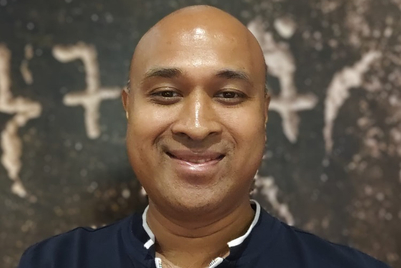What brings you to India?
Tor Myhren (TM): A lot of things. We had our global creative council here for the regional business summit in Delhi. All the CEOs and CCOs from all across Apac came together for that. Then, for the weekend I headed to Udaipur. And now, I’m here in the Mumbai office for a few days. I really want to spend some time here, because it’s a very important office for us. The global creative council features
the 15 best creative directors in the Grey Network. It includes Malvika Mehra from India. We meet twice a year. We’ve done it in Mumbai, New York, the Ice Hotel in Sweden. The next one will be in Africa.
What’s the agenda of the meeting?
TM: There are two things. One is, we share best practices and sometimes present winning pitch ideas to the other creatives. We also talk about cultural things we’re doing in offices and share what is working and what isn’t. We also look at all the work, from all 130 offices from around the world. Each of these offices send in their best pieces of work, and we judge and give it a number (from 1 to 10) for each.
Then each office gets a ranking. It’s very competitive.
Where does India rank?
TM: India’s always done pretty well and is high up this year too.
What has been the experience for Grey so far this year and what are your goals and targets for the rest of the year?
TM: We have a lot of really good things going on right now. The goal is to continue to create the kind of work that’s getting talked about in culture. We have a lot of campaigns that are either out there in the market place or that are about to come out, that have the potential to become a part of popular culture and talked about. So, I’m very optimistic about 2015.
Malvika Mehra (MM): From the Indian perspective, it sounds very generic, but it’s always been about good work. We’ve gained a lot of momentum in the past two months. To be frank I think we had plateaued a bit towards the end of last year. But, this is a second wind, and we’ve won accounts like the Indian Army and some government accounts in Delhi. We’ve got a couple of new pieces
out recently – the Gillette film featuring Dravid which has close to three million hits. The Swachch Bharat campaign was another well received one. We’ve also got the Maneka Gandhi
portfolio about women and child welfare. Our attempt on the government businesses is work which isn’t typical ‘government work’. We’ve seen a lot of advertising work around the government which is s***. Sorry, but it is really bad work. The attempt is to not just make it look good, but make it have
some behaviour change.
The first campaign for Swachch Bharat was about the clap of shame, and was to embarrass people. That’s seen some traction. There was a recent gathering at Bandstand in Mumbai, where kids got together for a clean-up movement. Suddenly, one of the teachers saw the kids clapping. The kids clapped because one guy came and dumped everything. When the kids were asked why, they said they’d seen this on TV and so they thought that was the most appropriate thing to do when
someone litters. These are the kind of things that’ll actually make change and a difference.
We’ve also tried something with female foeticide with the handcuffs. The thought is ‘arresting a thinking’. So, stuff like this is making a difference and that’s what we’re hoping to do. We’re pitching a lot too.
Which are the top markets for the agency and where does India rank, in terms of creative product? How has this changed?
TM: The best offices we have creatively are – New York, London, Ecuador (which won eight Cannes Lions last year), Argentina, Sweden, Germany and Canada. The Canadian office was ranked number one in our meeting earlier and it’s a small office of about 60 to 70 people. We need more offices to be doing better work all over the world. That’s part of my job now. India and China are the two big Asian markets right now doing a good job. India is strong. But, Malvika and I agree on this that it needs to get bigger. There’s been a nice turn in the last few months with a few new business wins and some work. Overall, the work needs to be improved in India and it certainly
needs to improve in China. The other very strong office in Asia is Singapore, where we’ve been
doing some consistent work.
How has Grey equipped its creatives for the digital age?
TM: I would say we’re strongly equipped. Even talking about digital in our industry is weird right now
because everything is digital. So, in a lot of our offices we’ve even taken out the ‘digital’ title because everyone is digital. I really like where we’ve come now. A good example is from our New York office. We went from having 20 people in digital five years ago, to now having 200 people who’ve come from a digital background. That will only increase in percentage across all our agencies.
We all know the industry is going that way.
We’ve seen Amit Akali move out the Indian office last year. What is the approach to retaining creative talent in a world where they’re moving to other industries?
TM: As long advertising has been around, this issue has been there. The industry tends to reward creatives for moving, monetarily especially. So, you have to create a culture that people want to be a part of. One thing we’re finding now is that a lot of people who leave Grey, return soon after because the culture is very strong. They move to other agencies, where they might be making
more money; but they find out that they want to be part of a work environment that they enjoy walking into as that motivates and inspires them. We need to create that environment within all of our offices in Grey.
Are we seeing this in India?
MM: Yes, I’ve seen this happen in our Delhi office. I’ve seen some kids who left the agency return
within six months. That’s encouraging. I think it is the buzz of the place and our extreme enthusiasm to do good work. Very often there are places where compromises are made in terms of creative ideas, where you get push backs from clients. But, I think here we make sure that we’re pushing for the good idea always and a lot of creatives support that.
TM: You bring up a good question about other industries. I think that’s a bigger issue and it is a bit of a crisis. It’s attracting the best young creative talent coming out of school into advertising. They’re choosing Apple, Facebook, Google and the likes. So, we need to be doing the kind of work and creating the kind of things that are competing with all of the best creative work out there. It’s not about advertising work alone, but the technology companies along with stuff like Hollywood and Bollywood. That’s what we are up against now. You’re fighting for the attention of people.
You’re fighting for the hearts of these young and very talented creative people. We as an industry have to make them come to advertising. This is what we have to wrap our heads around. Right now it’s a crisis because we’re losing people to other industries. There’s only one solution for this – it’s the work. You have to create things, that are not necessarily ads anymore, that attracts young creative minds. We need a fundamental change to bring people back to the industry.
MM: When we’re hiring talent we shouldn’t look at the typical conventional schools. I have some of
the best art directors who have no art background. We’ve also got a couple of kids who are stand up comedians as copywriters. They add so much more to the party. They’ll create a jingle, or perform a rap song on the spot for our clients and that just pushes the meeting somewhere else. So, I think creative directors need to be creative and sensible in where they’re hiring from too.
The Gunn Report was released recently. From India, Grey had moved up to the top five. Do things like the Gunn Report matter to you?
TM: It’s a loaded question. I would tell you that the Gunn Report doesn’t matter to me personally.
But, I do think it matters to some of our agencies worldwide. It depends on what part of the world it is in. The fact that Grey is in the top five in India is great and I think it’ll help attract talent and clients.
In some markets it doesn’t matter. Some of our biggest offices only enter a handful of shows which we think really matter to that market. I think what matters to us more than awards is doing work that is finding its way into pop culture, and work that is talked about.
The group’s Singapore office won the Global Healthcare Agency of the Year at the New York Festivals’ Global Awards... how is this vertical growing globally and in India?
TM: Healthcare is growing faster than any sector in our business. So, it’s a really important category. I believe the work in this category all over the world is getting better. It’s not great yet, but I think it is getting there. There will be a turning point when a lot of healthcare companies start doing a lot of creative work.
MM: We handle GSK here in India. But we’re not pitching for more healthcare brands in a crazy manner. I don’t think the industry is so strong in India currently, but it is growing.
What are the other challenges you foresee?
TM: There are a million challenges! Attracting young talent is the number one issue. Our content competing with all of the other creative industries out there is one more challenge. Further, I think there continues to be a challenge with really true and pure integration, where agencies have no walls and divisions, whether it’s digital/mobile content or films or technology. Integrating all that and allowing all of the subject matter experts to have a voice at the table is hard because ultimately one person has to make a decision. But, the industry is growing and I do believe there will always be a need for creative storytelling. In whatever media format, but as long as we tell relevant stories, creatively, we’ll all have jobs.
(Published in the issue of Campaign India dated 20 March 2015.)
.jpg&h=570&w=855&q=100&v=20250320&c=1)
.jpg&h=570&w=855&q=100&v=20250320&c=1)


.jpg&h=334&w=500&q=100&v=20250320&c=1)

.jpg&h=334&w=500&q=100&v=20250320&c=1)


.jpg&h=334&w=500&q=100&v=20250320&c=1)


.jpg&h=334&w=500&q=100&v=20250320&c=1)





.jpg&h=268&w=401&q=100&v=20250320&c=1)
.jpg&h=268&w=401&q=100&v=20250320&c=1)

.jpg&h=268&w=401&q=100&v=20250320&c=1)
